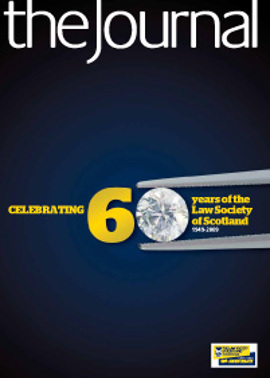Sins of emission

The Climate Change (Scotland) Bill was introduced into the Scottish Parliament on 4 December 2008, and is currently making its way through the parliamentary process. The Scottish bill follows the UK Climate Change Bill, now Act, which was given Royal Assent on 26 November 2008. Following the Scottish Parliament’s agreement on 20 December 2007 to a legislative consent motion, most of the provisions of the UK Act will also extend to Scotland. However, the Scottish bill also impacts over a range of climate change issues, set out in five parts of the bill, each with its own implications. This article seeks to outline the main changes.
Emissions reduction targets
Part 1 is the foundation of the bill, setting a general duty on Scottish Ministers to reduce the net Scottish emissions account by 50% by 2030, and 80% by 2050, by way of annual emissions reduction targets.
Monitoring performance
In order to ensure these targets are met, Parts 2-4 follow with a range of scrutiny measures. These include the possible creation of the Scottish Committee on Climate Change, which can provide expert advice and independent scrutiny of target compliance. A reporting duty imposed on Scottish Ministers also ensures annual targets are met. Finally, s 36 enables the Scottish Ministers to create secondary legislation to impose and monitor duties on public bodies, such as emissions reduction. This latter provision will perhaps be similar to duties imposed by legislation such as the Nature Conservation (Scotland) Act 2004, which places a duty on public bodies to further the conservation of biodiversity.
Other climate change provisions
Part 5 contains a variety of further measures.
Muirburn (s 46)
The term “muirburn” relates to the land management technique of controlled burning of vegetation on open semi-natural habitats. This section enables Scottish Ministers to lay orders to vary the muirburn dates (currently in the Hill Farming Act 1946), where necessary to do so in relation to climate change, and will be important for landowners, estate managers, hill farmers, gamekeepers and crofters.
Forestry Commission (s 47)
Section 47 of the bill relates to the modification of the Forestry Commission functions. Scottish Ministers have stated that they will use these powers to allow the Forestry Commission to enter into joint ventures with developers and local communities for renewable energy development in the national forest estate.
Energy efficiency (ss 48-51)
Sections 48-51 aim to improve the energy efficiency of domestic, business and public sectors in Scotland, introduce regulations for the assessment of non-domestic buildings and make provision for Scottish Ministers to promote the use of heat produced from renewable sources.
- Waste reduction and recycling (ss 52-61)
- Scottish Ministers may introduce new obligations on businesses and public bodies to provide:
- waste prevention and management plans
- information to SEPA on waste they produce
- facilities for deposit of recyclable waste
- a minimum percentage of recyclate on goods they procure.
- Ministers may also set:
- targets for reduction of packaging
- charges for supply of carrier bags, with the net proceeds being applied to environmental good causes
- deposit and return schemes for packaging associated with specified products.
The Scottish Government’s Zero Waste Consultation states the earliest these provisions could be brought into force by subsequent legislation will be 2015. Enforcement will be carried out by bodies such as SEPA and local authorities, who will be given the power, under s 61, to impose financial penalties for non-compliance.
One to watch
The bill provides the primary legislation necessary to give the Scottish Government the power to achieve emission reductions targets as set out in Part 1 of the bill. The legal framework of the bill will be supplemented by secondary legislation and other statutory mechanisms. Achieving these ambitious targets is likely to have far-reaching consequences, and it will be necessary to monitor the passage of the bill and the rollout of secondary legislation and other statutory mechanisms.
In this issue
- Defining year
- At the heart of the debate
- In shape at 60
- Banks doing business
- To take us forward
- Striving after fairness
- Knowledge is protection
- The changing role of the law school
- Risk: nip it in the bud
- Close relations
- Conference keeps getting better
- Booming baby boomer
- Channel vision
- Variations on a theme
- Customer survey scores a plus
- Prepare for the upturn
- New look Society gets go-ahead
- Backing for "Wider Choice"
- Private client tax specialists recognised
- Law reform update
- From the Brussels office
- Target 2010
- Questions of our times
- Ask Ash
- Breaking the chain
- What will they do next?
- Sins of emission
- Scottish Solicitors' Discipline Tribunal
- Are we ready?
- Website review
- Book reviews
- Duty within bounds
- Change to fair
- Home reports update






